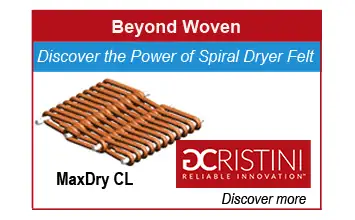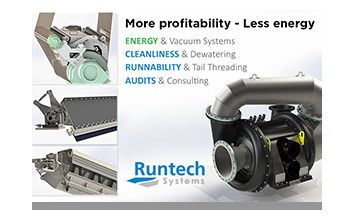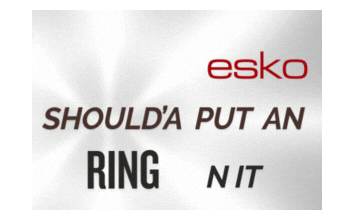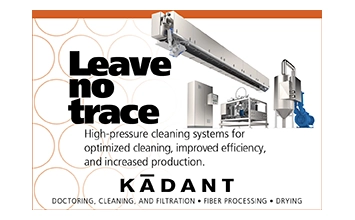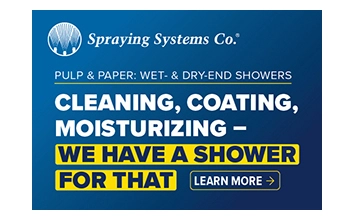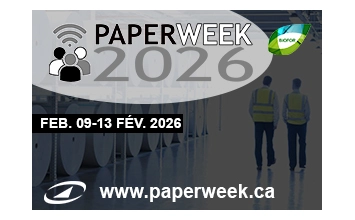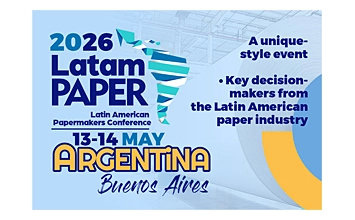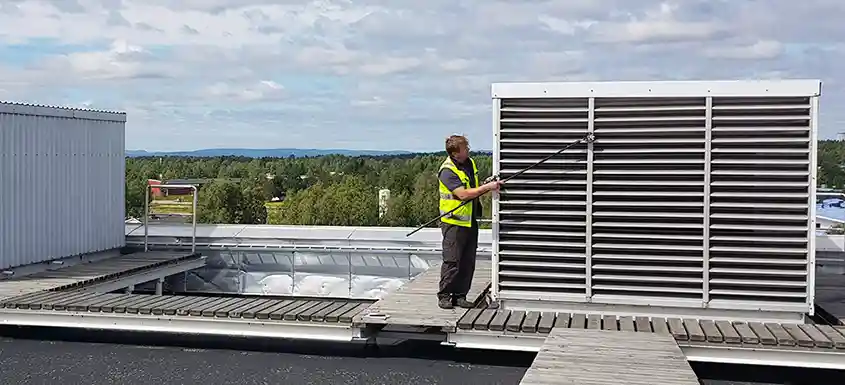HP Cleaning Showers are essential on all types of paper machines. They use high pressure solid stream nozzles combined with an oscillator to ensure the fabrics on the paper machine remain free of stickies, debris, and can drain the water from the paper web.
Often, there are several ways to optimize these showers to enhance performance, prolong the life of fabric, and ensure product quality is at its highest.
There are HP Cleaning Showers found within both the forming and press sections of a paper production machine. These showers are crucial for ensuring product quality and a long lifespan of the fabrics on the machine. The following are recommendations for setting up both the inside and outside HP cleaning showers. Additionally, we will address the proper set up of oscillators to get the best performance possible.
Forming Section HP Cleaning Showers

Figure 1: Forming Section Overview
Inside and Outside HP showers have different intentions in the forming section; therefore, they will be set up differently from one another. The inside shower is meant to clean any debris that becomes trapped within the fabric itself. By blasting from the inside out, this shower uses its power to push any internal debris back to the outside of the fabric. Doing this allows the internal void volume to be clean and free of contamination. It also sets the stage for the sheet side of an HP shower. The sheet side HP shower is meant to remove any surface contamination from the fabric. All the debris pushed to the outside from the Inside shower along with contamination like stickies, fibers, and fines can then be scraped off by this sheet side shower.
Inside HP Cleaning Shower
Let’s investigate how the inside HP shower should be arranged. Due to the nature of this shower cleaning the inside of the fabric, the spray distance should be set to be between 3 to 4 inches from the fabric. At this spray distance, we get the most powerful laminar flow stream of water from the nozzle to the fabric. This correlates with transmitting the full impact energy from the nozzle’s water stream to the fabric (or fabric voids). The internal debris can be pushed out to the sheet side of the fabric allowing for the sheet side HP shower to take care of the rest. Another shower that works similarly to the inside HP cleaning shower is the flooded nip shower. The high volume of water forces itself from the inside to the outside carrying any debris with it.
 Figure 2: Jet Efficiency
Figure 2: Jet Efficiency
For the angle and direction of this shower, we tend to recommend a range of 0 degrees up to 15 degrees with the fabric running direction. This helps to reduce any splashing that may occur as well as prevent an unintentional “chiseling” action to knock debris off the inside of the fabric onto nearby equipment like rolls or other areas of the fabric. Typical pressure range for this type of shower ranges from 70-290psi.
 Figure 3: Inside HP Cleaning Shower Orientation
Figure 3: Inside HP Cleaning Shower Orientation
Sheet Side HP Cleaning Shower
The sheet side HP cleaning shower takes all the debris that has been gathered to the outside and cleans it off into the pit with a chiseling action. This shower is set up slightly different from the inside shower because they serve different purposes. Firstly, the spray distance should be set to 6 to 8 inches away from the fabric. This is due to the need for a two-phase liquid for more cleaning power. As the jet stream begins to mix with the surrounding air, droplets are formed that provide high powered impact with the fabric material. This helps tremendously with cleaning effectiveness. We also highly recommend this shower be placed near the front of a roll or even directly on the roll to keep the impact energy at its highest.
This shower is directed at the fabric; we recommend setting the angle between 0 deg to 20 degrees against the fabric’s run direction. Positioning the shower against the run of the fabric allows the shower to perform its chiseling action to clean the surface of the fabric. With regards to a pressure range for this shower, we recommend between 120psi up to 420psi based on the type of fabric being cleaned. The lower the pressure can be kept on these showers, the better it will be for the wear life of the fabric itself. Of course, it is important to keep excellent cleaning efficiency while trying to keep the pressure low. If the pressure is too high, it is possible to damage the fabric.
 Figure 4: Sheet Side HP Cleaning Shower Orientation
Figure 4: Sheet Side HP Cleaning Shower Orientation
Press Section HP Cleaning Showers
The HP cleaning showers in the press section of the paper machine are set up similarly to those in the forming section, with minor modifications.
 Figure 5: Press Section Overview
Figure 5: Press Section Overview
Inside HP Cleaning Shower
As seen with operations within the Forming Section, Inside HP Cleaning showers, in the Press Section are set up very similar, with some minor tweaks. The press section inside shower is typically setup on the pick-up and first press fabrics. As more press sections may be present on a machine, you may notice the inside HP cleaning wire may become less used. This is simply because the moisture content of the web has become drier and there is less debris getting trapped in the fabric itself. An outside HP cleaning shower will take care of the further press sections on a paper machine.
This shower’s purpose in the press section is to remove the contaminants from the void of the fabric to push them towards the surface. It is best to position this shower nearby to a suction box as this will aid in the removal of contaminants from the surface of the fabric. For this type of shower, it should be positioned between 3” to 6” from the surface of the fabric. The nozzles should be on 3” centers with an oscillation of 6” to achieve double coverage should a nozzle become clogged at some point in the process. The pressure should be operated between 200psi to 350psi, and the angle of the shower should be perpendicular to the surface with up to 15 degrees towards the direction of the fabric run.
Sheet Side HP Cleaning Shower
The sheet side HP Cleaning shower is probably the most important shower in the cleaning system. Like in the forming section, it is also used in the press section to clean the press fabrics with constant operation to remove contaminants from the surface. A typical shower arrangement will have nozzles on 3” centers with an oscillation stroke of 6” for double coverage should a nozzle clog during operation. The shower should be angled approximately 15 deg against the run of the fabric. The operating pressure should be between 150psi to 300psi with a spray distance between 6in to 8 in. The sheet side HP cleaning shower should be located and used before a roll to ensure the contaminants are removed before being forced deeper into the fabric.
Oscillators
A few notes about oscillators. All HP Cleaning showers with solid stream nozzles will require an oscillator. Without an oscillator, the solid stream spray pattern would eventually tear through and destroy the fabric. The oscillator should move the shower that it is attached to one nozzle orifice diameter, typically 1mm, per rotation of the entire fabric. This not only ensures that the nozzles do not repeatedly meet the same spot but also makes sure the entire fabric is getting cleaned properly.
 Figure 6: Oscillator Mounting Arrangements
Figure 6: Oscillator Mounting Arrangements
Summary
We have found these suggestions to be helpful for a lot of paper manufacturers. These are meant to be guidelines to help improve fabric cleanliness which can lead to overall process improvement. Spraying Systems Co has been in business since 1939 and knows the ins and outs of the paper industry. We are always available to help with any spray applications.
About the Author
Bernard Pyzdrowski is the project engineer for pulp and paper Industries at Spraying Systems Co.
About Spraying Systems
Spraying Systems Co. is the world’s leading manufacturer of spray nozzles. Every day, our local spray technology experts help customers optimize operations and create more sustainable manufacturing practices. With tens of thousands of standard products, we have the right nozzle for your application – and we ship most standard products in one day. If you need a special product or material, contact us! We develop hundreds of custom nozzles, injectors and headers every year. Our engineering and manufacturing resources can help solve your toughest spray technology challenges.






